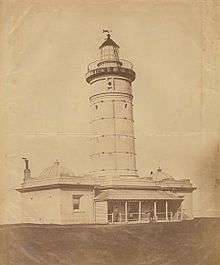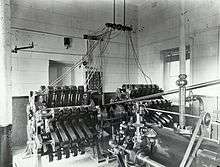Macquarie Lighthouse
 Macquarie Lighthouse, Dunbar Head | |
 Location in New South Wales | |
| Location |
Vaucluse New South Wales Australia |
|---|---|
| Coordinates | 33°51′14.2″S 151°17′06.6″E / 33.853944°S 151.285167°ECoordinates: 33°51′14.2″S 151°17′06.6″E / 33.853944°S 151.285167°E |
| Year first constructed | 1818 (first) |
| Year first lit | 1883 (current) |
| Construction | sandstone tower |
| Tower shape | cylindrical tower with balcony and lantern atop service building |
| Markings / pattern | white tower and lantern |
| Height | 26 metres (85 ft) |
| Focal height | 105 metres (344 ft) |
| Original lens | 1st order sixteen sided Fresnel lens (1883) |
| Current lens | 1st order bivalve Fresnel lens (1933) |
| Intensity | 800,000 candela |
| Range | 25 nautical miles (46 km; 29 mi) |
| Characteristic | Fl (2) W 10s. |
| Admiralty number | K2632 |
| NGA number | 111-6316 |
| ARLHS number | AUS-218 |
| Managing agent | Sydney Harbour Federation Trust |
The Macquarie Lighthouse, also known as South Head Upper Light, was the first, and is the longest serving, lighthouse site in Australia. It is located on Dunbar Head, Vaucluse, about 2 kilometres (1 mi) south of South Head) near the entrance to Sydney Harbour. There has been a navigational aid in this vicinity since 1791 and a lighthouse near the present site since 1818. The current lighthouse was completed in 1883.
The lighthouse is still fully operational and is under the control of the Australian Maritime Safety Authority. The grounds are managed by the Sydney Harbour Federation Trust.[1]
The lighthouse is featured on the arms of Macquarie University. In 2008, the University introduced an official logo, described as an 'abstract, timeless image' of water lilies, as its public visual identity; use of the arms was subsequently restricted to official documents such as graduation testamurs and legal documentation.
History

In 1791 and within one year of the arrival of the First Fleet, a flagstaff was erected on the site. This was followed, in 1793, by a tripod mounted iron basket which originally burned wood, and later coal.
On 11 July 1816 the foundation for the first lighthouse was laid by Lachlan Macquarie, Governor of New South Wales, who called it Macquarie Tower. It was designed by Francis Greenway, a famous convict architect, under the instructions of Macquarie, and built in soft sandstone. The lighthouse was first lit on 30 November 1818.
The soft sandstone proved short-lived, and even as early as 1823 it started crumbling, and large steel bands were placed to keep the structure together. By 1878 the NSW Government decided a new tower was needed. The construction of the new tower started in 1881, just 4 metres (13 ft) away from the original structure. It was officially lit in 1883.
The new lighthouse was designed by James Barnet in a design similar to the original tower, albeit built in stronger materials. The crown and the lantern room were larger so a larger apparatus can be accommodated. Also added was a black gunmetal railing, which was to become one of Barnet's hallmarks.
The original lens was a Chance Brothers 2 metres (6 ft 7 in), sixteen sided, dioptric, holophotal, Fresnel lens, with a characteristic of one eight second white flash every minute (L Fl W. 60s), visible for 25 nautical miles (46 km; 29 mi).


The original light source used on clear weather was a gas burner. On bad weather an electric arc lamp was used, electricity being supplied by a de Méritens generators driven by a Crossley coal gas engine. On especially bad weather a second generator was also operated, resulting in a 6,000,000 cd light, the world's most powerful at the time. One of the generators, the switchboard and one arc lamp still exist, owned by the Powerhouse Museum. The generator and the switchboard are on display at the lighthouse.
The lantern of the old lighthouse was immediately removed, and the structure was demolished several years later.
In 1912 the apparatus was converted to a vaporised kerosene mantle, to lower costs. In 1933 the light returned to use electricity, as the tower was connected to mains electricity. The current first order bivalve Fresnel lens was installed at that time.[2]
In 1976 the Macquarie Lighthouse was fully automated, the last lightstation staff left the site in 1989. The grounds were transferred to the management of the Sydney Harbour Federation Trust in 2001.[1]
The two remaining cottages on the site include the head keeper's cottage built circa 1840 on the south side and the assistant lighthouse keepers' semi-detached cottages built in 1881 on the north side (converted into one cottage circa 1991). The former is now the oldest intact freestanding lightkeeper's quarters in Australia. Both these cottages are on 125 year Commonwealth leases to end between 2116 & 2119. A third cottage for the engineer and assistants built in 1885 was demolished in 1970 to make way for four townhouses still present on the site.[3] In 2004, the head keeper's cottage (on the south side) was offered for sale at a price of A$ 1.95 million.[2]
See also
Notes
- 1 2 "Sites - Macquarie Lightstation". Sydney Harbour Federation Trust. Archived from the original on February 9, 2006. Retrieved April 18, 2006.
- 1 2 Rowlett, Russ. "Lighthouses of Australia: New South Wales". The Lighthouse Directory. University of North Carolina at Chapel Hill. Retrieved July 21, 2008.
- ↑ Sydney Harbour Federation Trust's Management Plan - Macquarie Lightstation (part 3). Retrieved 2 Nov, 2010
References
- "Macquarie Lighthouse". Lighthouses of New South Wales. Lighthouses of Australia Inc.
- List of Lights, Pub. 111: The West Coasts of North and South America (Excluding Continental U.S.A. and Hawaii), Australia, Tasmania, New Zealand, and the Islands of the North and South Pacific Oceans (PDF). List of Lights. United States National Geospatial-Intelligence Agency. 2009. p. 129.
- Searle, Garry. "Macquarie". Lighthouses of New South Wales. SeaSide Lights.
External links
| Wikimedia Commons has media related to Macquarie Lighthouse. |
- Harbour Trust, Macquarie Lightstation
- Robin Derricourt (2008). "Macquarie Lighthouse". Dictionary of Sydney. Retrieved 8 October 2015. [CC-By-SA]
